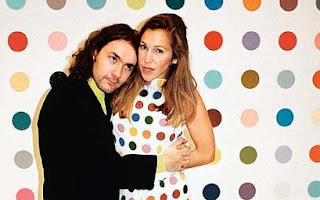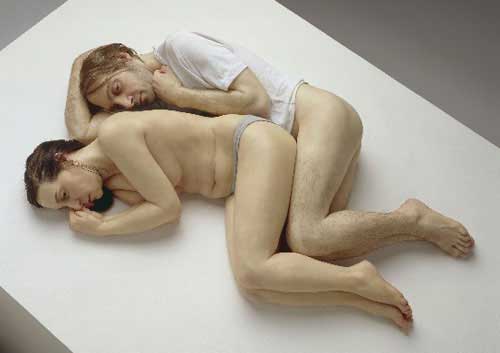 |
Self Portrait in Fur Coat (1500) Albrecht Durer |
 |
| Knob (1997) Gavin Turk |
 | | | |
| Damien Hirst and Maia Norman (1995) | | | | |
1. Identify aspects of Durer's self portrait that show a changing view of the artist's view of himself as an individual.
The self portrait was painted just before he's 29th birthday. It was a portrait of him when he was 28. It was seemed as a Christlike image, it may have been meant by Dürer to remind the viewers that an artist's creativity and art skills , e.g. painting, is given by God. The portrait has been described with Facing strait forward, wearing a brown robe with a dark brown fur collar and ornamental notches on the sleeves, he is delicately grasping the fur of the collar, and he seems to be showing a tiny bit of a white T-shirt under the coat.
I think the way he painted himself with the dark background to have a contrast with himself is to show an importance in him. I think he wanted to show that he is different to every other people, that he is unique is his own way. I agree with the face that he may have painted himself as in a Christlike position as, "He has a short beard and moustache. Durer has even painted himself with brown hair, although the other self-portraits show that it was actually reddish-blond. Durer deliberately set out to create a Christ-like image, with his hand raised to his chest almost in a pose of blessing. " He didn't just painted this out of interest but in deed he so himself thought that he is amazing. To back up on that, he portrayed himself in fine clothes, not as a simple German craftsman like his father, a goldsmith in Nuremberg, but as a glamorous international artist, a man of style and sophistication.
2. Explain how the artist's social status increased during the Renaissance period. Briefly explain why this happened.
Dürer is truly an amazing renaissance master who made two trips to Venice in his lifetime, explores the same rhapsodic, full-frontal sensuality as the Venetian Giovanni Bellini - who was to become Dürer's friend. In 1498 after he painted one of his other portraits ,(I painted this from my own appearance; I was twenty-six years old), he's social status increased to a upper social circle of the city, the Ehrbaren, or wealth merchant. During the Renaissance period, a member of the Milanese aristocracy, Giovanni Antonio Boltraffio’s epitaph stressed that although he was a painter, he was an amateur, because if it were thought that he made his living from painting it would significantly lower his social status. It is for this reason that few people in the early Renaissance would see painting as a method of social advancement or to demonstrate intellectual ability. This did not however stop many painters having aspirations for higher social and intellectual status, despite their background and education rarely supporting this aspiration.At that time, artists were seen more worthy if they were educated and "geometry" was one of the subject for a certain technique used in their painting and by the early practices, it is to be proved that the technique was very hard to master. Liberal art was then the key to elevate the artists social status and intellectual level. There were a maybe in whether paintings could be considered wordless poems. It was perhaps to gain a better social standing that many Renaissance artists aspired to write poetry. So I think that the artists' social status increased because they started to combine their art with education and other knowledge and not just simply painting.
3. Comment on Gavin Turk's work in relation to individualism, status of the artist and egotism.
To me, his work above was a very obvious relation to individualism, status of the artist and egotism. The work looks like a signature to me and normally signatures are black ink on white paper or in a single colour but Gavin's signature is in multiple colours which shows that it is different than other people. Signatures are to show who we are, therefore, Turk's unique signature showed that he is different with an artistic touch. Turk lives and works in London and he's works deals with authorship, authenticity and identity. Turk explored issues of individualism and identity by making art based on his own signature that have the value of an artist's name confers onto a work which to me showed his uniqueness . He has also made a number of photographic and sculptural self-portraits that often involve some degree of disguise. One of his best-known sculptures, Pop (1993), is a life-size waxwork self-portrait in which he adopts the identity of Sid Vicious singing 'My Way' in the pose of Elvis Presley as depicted by Andy Warhol. Turk shows his work of art is with artist status and meaningful value.
4. Comment on Damien Hirst's use of his work and the media for self promotion.
Damien Hirst is famous for putting dead animals in a vitrine as his art. During the 1990s, he became the most famous , young, living sculptor and painter, in part because of his own flair for-self-promotion and the publicity skills.While still a student in 1988, Hirst conceived, organized and promoted "Freeze", an exhibition held in a Docklands warhouse. The show featured several of Damien's pieces. This amazingly successful self-promoted exhibition is widely believed to have been the starting point of the "Young British Artists" movement. Most of his art work are promotions to himself in public and because of this, he soon became famous and rich.
5. Find 2 images of work by artists or designers that reflects some of the ideas of individualism,
self promotion or egotism that have been discussed on this blog. Upload images to your blog, title and date the work, identify the artist/designer and comment on the work in relation to the question.
 |
Edward Hopper Self-Portrait
1925-30
Oil on canvas
25 1/16 x 20 3/8 in. | | | |
| |
|
|
|
Edward Hopper is one of the most famous artist in America. In this portrait he didn't show any sighs or clues who he was but he painted himself as an "anonymous contributor to American prosperity". he was willing to pass as a blue-eyed chronicler of the American scene, Norman Rockwell with angst. "The critics give you an identity," Hopper wrote. "And sometimes, even, you give it a push." Hopper's push was to paint recognizably American subjects—the all-night cafes, lonely hotel rooms, and aging Victorian houses at the heart of the Museum of Fine arts, Boston —while hinting at a more private, covert emotional landscape.
 |
ELIZABETH ARDEN Green Tea Scent SprayElizabeth Arden established the American beauty industry a century ago. Born Florence Nightingale Graham, she traveled from rural Canada to New York City, where she opened the first Red Door salon on Fifth Avenue in 1910. Elizabeth Arden’s fundamental belief was that beauty should not be a veneer of makeup , but an intelligent cooperation between science and nature in order to develop a woman’s finest natural assets. She lived by her mantra, "To be beautiful and natural is the birthright of every woman." Her works were named after her just like Gavin Turk's work with his unique signature. The names of her products are all of elegant names ; just like this perfume "Green Tea". The bottle and the fragrant inside are all very light and classy like. As if after the users used her perfume, they will become beautiful and natural. I think that every product is like her own self and she want to spread her words by using her products, telling all the women they can be beautiful.
6. How do you think artists and designers are viewed in Western society today? I think that artists and designers are an entertainment or "happiness" creator in the western society. People buy paintings, by designer products to fulfill their unrealistic needs. Just like what Barbara Kruger was trying to tell us through her work saying that shopping is our lifestyle and our "happiness" but really, they are all unnecessary needs. But there is also good things like admiring the artists and designers' creativity and gain our knowledge about art and design. WebMuseum http://www.ibiblio.org/wm/paint/auth/durer/self/ Albrecht Durer http://www.moodbook.com/history/renaissance/durer-portraits.html#self-portrait-in-a-fur-collared-robe
Divine inspiration http://www.guardian.co.uk/artanddesign/2002/nov/30/art.artsfeatures1 The Self-Portraits of Albrecht Dürer http://www.oneonta.edu/faculty/farberas/arth/arth200/artist/durer_intro.html tellectual Life of the Painters of the Early Renaissance http://www.123helpme.com/view.asp?id=37861 Gavin Turkhttp://gavinturk.com/biography/
Sean Kelly gallery http://www.skny.com/artists/gavin-turk/ Damien Hirst : Art in the age of mass media http://www.artdesigncafe.com/Damien-Hirst-media-celebrity-2001 D a m i e n h i r s t b i o g
http://www.leninimports.com/damien_hirst.html Edward Hopper's secert world http://www.slate.com/id/2165773/slideshow/2165806/fs/0//entry/2165807/ ELIZABETH ARDEN http://learnmore.elizabetharden.com/about-elizabeth-arden/
|






















